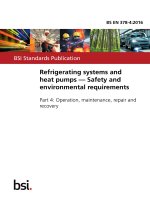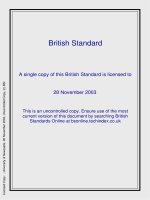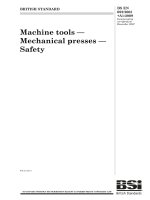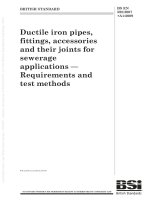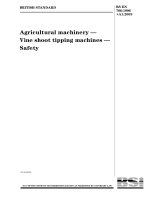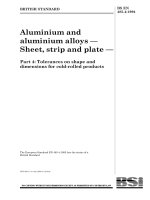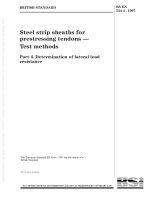Bsi bs en 61000 4 2 2009
Bạn đang xem bản rút gọn của tài liệu. Xem và tải ngay bản đầy đủ của tài liệu tại đây (1.3 MB, 68 trang )
BS EN 61000-4-2:2009
BSI British Standards
Electromagnetic compatibility
(EMC) —
Part 4-2 : Testing and measurement techniques —
Electrostatic discharge immunity test
NO COPYING WITHOUT BSI PERMISSION EXCEPT AS PERMITTED BY COPYRIGHT LAW
raising standards worldwide™
BRITISH STANDARD
BS EN 61000-4-2:2009
National foreword
This British Standard is the UK implementation of EN 61000-4-2:2009. It is
identical to IEC 61000-4-2:2008. It supersedes BS EN 61000-4-2:1995, which
will be withdrawn on 1 March 2012.
The UK participation in its preparation was entrusted by Technical Committee
GEL/210, EMC - Policy committee, to Subcommittee GEL/210/12, EMC basic,
generic and low frequency phenomena Standardization.
A list of organizations represented on this committee can be obtained on
request to its secretary.
This publication does not purport to include all the necessary provisions of a
contract. Users are responsible for its correct application.
© BSI 2009
ISBN 978 0 580 56244 0
ICS 33.100.20
Compliance with a British Standard cannot confer immunity from
legal obligations.
This British Standard was published under the authority of the Standards
Policy and Strategy Committee on 31 May 2009
Amendments issued since publication
Amd. No.
Date
标准分享网 www.bzfxw.com 免费下载
Text affected
BS EN 61000-4-2:2009
EUROPEAN STANDARD
EN 61000-4-2
NORME EUROPÉENNE
March 2009
EUROPÄISCHE NORM
ICS 33.100.20
Supersedes EN 61000-4-2:1995 + A1:1998 + A2:2001
English version
Electromagnetic compatibility (EMC) Part 4-2: Testing and measurement techniques Electrostatic discharge immunity test
(IEC 61000-4-2:2008)
Compatibilité électromagnétique (CEM) Partie 4-2: Techniques d’essai
et de mesure Essai d’immunité
aux décharges électrostatiques
(CEI 61000-4-2:2008)
Elektromagnetische Verträglichkeit (EMV) Teil 4-2: Prüf- und Messverfahren Prüfung der Störfestigkeit gegen
die Entladung statischer Elektrizität
(IEC 61000-4-2:2008)
www.bzfxw.com
This European Standard was approved by CENELEC on 2009-03-01. CENELEC members are bound to comply
with the CEN/CENELEC Internal Regulations which stipulate the conditions for giving this European Standard
the status of a national standard without any alteration.
Up-to-date lists and bibliographical references concerning such national standards may be obtained on
application to the Central Secretariat or to any CENELEC member.
This European Standard exists in three official versions (English, French, German). A version in any other
language made by translation under the responsibility of a CENELEC member into its own language and notified
to the Central Secretariat has the same status as the official versions.
CENELEC members are the national electrotechnical committees of Austria, Belgium, Bulgaria, Cyprus, the
Czech Republic, Denmark, Estonia, Finland, France, Germany, Greece, Hungary, Iceland, Ireland, Italy, Latvia,
Lithuania, Luxembourg, Malta, the Netherlands, Norway, Poland, Portugal, Romania, Slovakia, Slovenia, Spain,
Sweden, Switzerland and the United Kingdom.
CENELEC
European Committee for Electrotechnical Standardization
Comité Européen de Normalisation Electrotechnique
Europäisches Komitee für Elektrotechnische Normung
Central Secretariat: avenue Marnix 17, B - 1000 Brussels
© 2009 CENELEC -
All rights of exploitation in any form and by any means reserved worldwide for CENELEC members.
Ref. No. EN 61000-4-2:2009 E
BS EN 61000-4-2:2009
EN 61000-4-2:2009
-2-
Foreword
The text of document 77B/574/FDIS, future edition 2 of IEC 61000-4-2, prepared by SC 77B, High
frequency phenomena, of IEC TC 77, Electromagnetic compatibility, was submitted to the IEC-CENELEC
parallel vote and was approved by CENELEC as EN 61000-4-2 on 2009-03-01.
This European Standard supersedes EN 61000-4-2:1995 + A1:1998 + A2:2001.
The main changes with respect to EN 61000-4-2:1995 are the following:
– the specifications of the target have been extended up to 4 GHz. An example of target matching these
requirements is also provided;
– information on radiated fields from human-metal discharge and from ESD generators is provided;
– measurement uncertainty considerations with examples of uncertainty budgets are given too.
The following dates were fixed:
– latest date by which the EN has to be implemented
at national level by publication of an identical
national standard or by endorsement
(dop)
2009-12-01
– latest date by which the national standards conflicting
with the EN have to be withdrawn
(dow)
2012-03-01
Annex ZA has been added by CENELEC..
www.bzfxw.com
__________
Endorsement notice
The text of the International Standard IEC 61000-4-2:2008 was approved by CENELEC as a European
Standard without any modification.
In the official version, for Bibliography, the following note has to be added for the standard indicated:
IEC 61000-6-1
NOTE Harmonized as EN 61000-6-1:2007 (not modified).
__________
标准分享网 www.bzfxw.com 免费下载
BS EN 61000-4-2:2009
-3-
EN 61000-4-2:2009
Annex ZA
(normative)
Normative references to international publications
with their corresponding European publications
The following referenced documents are indispensable for the application of this document. For dated
references, only the edition cited applies. For undated references, the latest edition of the referenced
document (including any amendments) applies.
NOTE When an international publication has been modified by common modifications, indicated by (mod), the relevant EN/HD
applies.
Publication
Year
IEC 60050-161
-
1)
IEC 60068-1
-
1)
Title
EN/HD
Year
International Electrotechnical Vocabulary
(IEV) Chapter 161: Electromagnetic compatibility
-
-
Environmental testing Part 1: General and guidance
EN 60068-1
1994
www.bzfxw.com
1)
Undated reference.
2)
Valid edition at date of issue.
2)
BS EN 61000-4-2:2009
–2–
61000-4-2 © IEC:2008
CONTENTS
INTRODUCTION.....................................................................................................................6
1
Scope ...............................................................................................................................7
2
Normative references .......................................................................................................7
3
Terms and definitions .......................................................................................................8
4
General .......................................................................................................................... 10
5
Test levels ...................................................................................................................... 10
6
Test generator ................................................................................................................ 10
7
6.1
6.2
6.3
Test
General ................................................................................................................. 10
Characteristics and performance of the ESD generator ......................................... 11
Verification of the ESD setup................................................................................. 14
setup ...................................................................................................................... 15
7.1
7.2
8
Test equipment ..................................................................................................... 15
Test setup for tests performed in laboratories ........................................................ 15
7.2.1 Test requirements...................................................................................... 15
7.2.2 Table-top equipment.................................................................................. 16
7.2.3 Floor-standing equipment .......................................................................... 17
7.2.4 Ungrounded equipment ............................................................................. 18
7.3 Test setup for post-installation tests ...................................................................... 22
Test procedure ............................................................................................................... 23
8.1
9
www.bzfxw.com
Laboratory reference conditions ............................................................................ 23
8.1.1 Environmental parameters ......................................................................... 23
8.1.2 Climatic conditions .................................................................................... 23
8.1.3 Electromagnetic conditions ........................................................................ 24
8.2 EUT exercising ...................................................................................................... 24
8.3 Execution of the test.............................................................................................. 24
8.3.1 Discharges to the EUT............................................................................... 24
8.3.2 Direct application of discharges to the EUT ............................................... 24
8.3.3 Indirect application of the discharge .......................................................... 26
Evaluation of test results ................................................................................................ 27
10 Test report...................................................................................................................... 27
Annex A (informative) Explanatory notes ............................................................................. 28
Annex B (normative) Calibration of the current measurement system and
measurement of discharge current ........................................................................................ 33
Annex C (informative) Example of a calibration target meeting the requirements
of Annex B ............................................................................................................................ 39
Annex D (informative) Radiated fields from human metal discharge and ESD
generators ............................................................................................................................ 45
Annex E (informative) Measurement uncertainty (MU) considerations .................................. 55
Annex F (informative) Variation in test results and escalation strategy ................................. 62
Bibliography.......................................................................................................................... 63
Figure 1 – Simplified diagram of the ESD generator .............................................................. 11
Figure 2 – Ideal contact discharge current waveform at 4 kV ................................................ 13
Figure 3 – Discharge electrodes of the ESD generator .......................................................... 14
标准分享网 www.bzfxw.com 免费下载
BS EN 61000-4-2:2009
61000-4-2 © IEC:2008
–3–
Figure 4 – Example of test set-up for table-top equipment, laboratory tests .......................... 17
Figure 5 – Example of test setup for floor-standing equipment, laboratory tests .................... 18
Figure 6 – Example of a test setup for ungrounded table-top equipment ............................... 20
Figure 7 – Example of a test setup for ungrounded floor-standing equipment........................ 21
Figure 8 – Example of test setup for floor-standing equipment, post-installation tests ........... 23
Figure A.1 – Maximum values of electrostatic voltages to which operators may be
charged while in contact with the materials mentioned in Clause A.2 .................................... 29
Figure B.1 – Example of a target adapter line attached to current target ............................... 34
Figure B.2 – Example of a front side of a current target ........................................................ 34
Figure B.3 – Example of measurement of the insertion loss of a current targetattenuator-cable chain .......................................................................................................... 35
Figure B.4 – Circuit diagram to determine the low-frequency system transfer
impedance ............................................................................................................................ 36
Figure B.5 – Typical arrangement for calibration of ESD generator performance................... 38
Figure C.1 – Mechanical drawing of a coaxial target (drawing 1 of 5) .................................... 40
Figure C.2 – Mechanical drawing of a coaxial target (drawing 2 of 5) .................................... 41
Figure C.3 – Mechanical drawing of a coaxial target (drawing 3 of 5) .................................... 42
Figure C.4 – Mechanical drawing of a coaxial target (drawing 4 of 5) .................................... 43
Figure C.5 – Mechanical drawing of a coaxial target (drawing 5 of 5) .................................... 44
Figure D.1 – Electric field of a real human, holding metal, charged at 5 kV measured
at 0,1 m distance and for an arc length of 0,7 mm................................................................. 48
www.bzfxw.com
Figure D.2 – Magnetic field of a real human, holding metal, charged at 5 kV, measured
at 0,1 m distance and for an arc length of approximately 0,5 mm .......................................... 48
Figure D.3 – Semi-circle loop on the ground plane ................................................................ 49
Figure D.4 – Voltages induced in a semi-loop ....................................................................... 50
Figure D.5 – Example of test setup to measure radiated ESD fields ...................................... 50
Figure D.6 – Comparison between measured (solid line) and calculated numerically
(dot line) voltage drop on the loop for a distance of 45 cm .................................................... 52
Figure D.7 – Comparison between calculated H field from measured data (solid line)
and H field calculated by numerical simulation (dotted line) for a distance of 45 cm ............. 52
Figure D.8 – Structure illuminated by radiated fields and equivalent circuit ........................... 53
Figure D.9 – Radiated H fields .............................................................................................. 54
Table 1 – Test levels............................................................................................................. 10
Table 2 – General specifications ........................................................................................... 12
Table 3 – Contact discharge current waveform parameters ................................................... 12
Table 4 – Cases for application of ESD on connectors .......................................................... 25
Table A.1 – Guideline for the selection of the test levels ....................................................... 30
Table B.1 – Contact discharge calibration procedure ............................................................ 37
Table E.1 – Example of uncertainty budget for ESD rise time calibration .............................. 59
Table E.2 – Example of uncertainty budget for ESD peak current calibration ........................ 60
Table E.3 – Example of uncertainty budget for ESD I 30 , I 60 calibration................................ 61
BS EN 61000-4-2:2009
–6–
61000-4-2 © IEC:2008
INTRODUCTION
IEC 61000-4 is a part of the IEC 61000 series, according to the following structure:
Part 1: General
General consideration (introduction, fundamental principles)
Definitions, terminology
Part 2: Environment
Description of the environment
Classification of the environment
Compatibility levels
Part 3: Limits
Emission limits
Immunity limits (in so far as they do not fall under the responsibility of the product
committees)
Part 4: Testing and measurement techniques
Measurement techniques
Testing techniques
Part 5: Installation and mitigation guidelines
Installation guidelines
Mitigation methods and devices
www.bzfxw.com
Part 6: Generic standards
Part 9: Miscellaneous
Each part is further subdivided into several parts, published either as international standards
or as technical specifications or technical reports, some of which have already been published
as sections. Others will be published with the part number followed by a dash and a second
number identifying the subdivision (example: IEC 61000-6-1).
This part of IEC 61000 is an International Standard which gives immunity requirements and
test procedures related to electrostatic discharge.
标准分享网 www.bzfxw.com 免费下载
BS EN 61000-4-2:2009
61000-4-2 © IEC:2008
–7–
ELECTROMAGNETIC COMPATIBILITY (EMC) –
Part 4-2: Testing and measurement techniques –
Electrostatic discharge immunity test
1
Scope
This part of IEC 61000 relates to the immunity requirements and test methods for electrical
and electronic equipment subjected to static electricity discharges, from operators directly,
and from personnel to adjacent objects. It additionally defines ranges of test levels which
relate to different environmental and installation conditions and establishes test procedures.
The object of this standard is to establish a common and reproducible basis for evaluating the
performance of electrical and electronic equipment when subjected to electrostatic
discharges. In addition, it includes electrostatic discharges which may occur from personnel to
objects near vital equipment.
This standard defines:
–
typical waveform of the discharge current;
–
range of test levels;
–
test equipment;
–
test setup;
–
test procedure;
–
calibration procedure;
–
measurement uncertainty.
www.bzfxw.com
This standard gives specifications for test performed in "laboratories" and "post-installation
tests" performed on equipment in the final installation.
This standard does not intend to specify the tests to be applied to particular apparatus or
systems. Its main aim is to give a general basic reference to all concerned product
committees of the IEC. The product committees (or users and manufacturers of equipment)
remain responsible for the appropriate choice of the tests and the severity level to be applied
to their equipment.
In order not to impede the task of coordination and standardization, the product committees or
users and manufacturers are strongly recommended to consider (in their future work or
revision of old standards) the adoption of the relevant immunity tests specified in this
standard.
2
Normative references
The following referenced documents are indispensable for the application of this document.
For dated references, only the edition cited applies. For undated references, the latest edition
of the referenced document (including any amendments) applies.
IEC 60050(161), International
Electromagnetic compatibility
Electrotechnical
Vocabulary
(IEV)
IEC 60068-1, Environmental testing – Part 1: General and guidance
–
Chapter
161:
BS EN 61000-4-2:2009
–8–
3
61000-4-2 © IEC:2008
Terms and definitions
For the purposes of this part of IEC 61000, the following terms and definitions apply and are
applicable to the restricted field of electrostatic discharge; not all of them are included in
IEC 60050(161) [IEV].
3.1
air discharge method
method of testing in which the charged electrode of the test generator is moved towards the
EUT until it touches the EUT
3.2
antistatic material
material exhibiting properties which minimize charge generation when rubbed against or
separated from the same or other similar materials
3.3
calibration
set of operations which establishes, by reference to standards, the relationship which exists,
under specified conditions, between an indication and a result of a measurement
NOTE 1
This term is based on the "uncertainty" approach.
NOTE 2 The relationship between the indications and the results of measurement can be expressed, in principle,
by a calibration diagram.
[IEV 311-01-09]
www.bzfxw.com
3.4
conformance test
test on a representative sample of the equipment with the objective of determining whether
the equipment, as designed and manufactured, can meet the requirements of this standard
3.5
contact discharge method
method of testing in which the electrode of the test generator is kept in contact with the EUT
or coupling plane and the discharge is actuated by the discharge switch within the generator
3.6
coupling plane
metal sheet or plate, to which discharges are applied to simulate electrostatic discharge to
objects adjacent to the EUT; HCP: Horizontal Coupling Plane; VCP: Vertical Coupling Plane
3.7
degradation (of performance)
undesired departure in the operational performance of any device, equipment or system from
its intended performance
NOTE
The term "degradation" can apply to temporary or permanent malfunction.
[IEV 161-01-19]
3.8
direct application
application of the discharge directly to the EUT
3.9
electromagnetic compatibility (EMC)
ability of an equipment or system to function satisfactorily in its electromagnetic environment
without introducing intolerable electromagnetic disturbances to anything in that environment
[IEV 161-01-07]
标准分享网 www.bzfxw.com 免费下载
BS EN 61000-4-2:2009
61000-4-2 © IEC:2008
–9–
3.10
electrostatic discharge (ESD)
transfer of electric charge between bodies of different electrostatic potential in proximity or
through direct contact
[IEV 161-01-22]
3.11
energy storage capacitor
capacitor of the ESD-generator representing the capacity of a human body charged to the test
voltage value
NOTE
This element may be provided as a discrete component or a distributed capacitance.
3.12
EUT
equipment under test
3.13
ground reference plane (GRP)
flat conductive surface whose potential is used as a common reference
[IEV 161-04-36]
3.14
holding time
interval of time within which the decrease of the test voltage due to leakage, prior to the
discharge, is not greater than 10 %
www.bzfxw.com
3.15
immunity (to a disturbance)
ability of a device, equipment or system to perform without degradation in the presence of an
electromagnetic disturbance
[IEV 161-01-20]
3.16
indirect application
application of the discharge to a coupling plane in the vicinity of the EUT to simulate
personnel discharge to objects which are adjacent to the EUT
3.17
rise time
interval of time between the instants at which the instantaneous value of a pulse first reaches
the specified lower and upper limits
NOTE
Unless otherwise specified, the lower and upper values are fixed at 10 % and 90 % of the pulse magnitude.
[IEV 161-02-05, modified]
3.18
verification
set of operations which are used to check the test equipment system (e.g., the test generator
and the interconnecting cables) and to demonstrate that the test system is functioning
NOTE 1
The methods used for verification can be different from those used for calibration.
NOTE 2 For the purpose of this basic EMC standard this definition is different from the definition given in
IEV 311-01-13.
BS EN 61000-4-2:2009
61000-4-2 © IEC:2008
– 10 –
4
General
This standard relates to equipment, systems, subsystems and peripherals which may be
involved in static electricity discharges owing to environmental and installation conditions,
such as low relative humidity, use of low-conductivity (artificial-fiber) carpets, vinyl garments,
etc., which may exist in all locations classified in standards relevant to electrical and
electronic equipment (for more detailed information, see Clause A.1).
NOTE From the technical point of view, the precise term for the phenomenon would be static electricity discharge.
However, the term electrostatic discharge (ESD) is widely used in the technical world and in technical literature.
Therefore, it has been decided to retain the term electrostatic discharge in the title of this standard.
5
Test levels
The preferred range of test levels for the ESD test is given in Table 1.
Contact discharge is the preferred test method. Air discharges shall be used where contact
discharge cannot be applied. Voltages for each test method are given in Table 1. The
voltages shown are different for each method due to the differing methods of test. This does
not imply that the test severity is equivalent between test methods.
Details concerning the various parameters which may influence the voltage to which the
human body may be charged are given in Clause A.2. Clause A.4 also contains examples of
the application of the test levels related to environmental (installation) classes.
For air discharge testing, the test shall be applied at all test levels in Table 1 up to and
including the specified test level. For contact discharge testing, the test shall be applied at the
specified test level only unless otherwise specified by product committees.
www.bzfxw.com
Further information is given in Clauses A.3, A.4 and A.5.
Table 1 – Test levels
Contact discharge
Level
1
2
3
4
x
a
6
6.1
a
Test voltage
kV
2
4
6
8
Special
Air discharge
Level
1
2
3
4
xa
Test generator
General
–
charging resistor R c ;
energy-storage capacitor C s ;
–
distributed capacitance C d ;
–
discharge resistor R d ;
voltage indicator;
–
kV
2
4
8
15
Special
"x" can be any level, above, below or in between the others. The level shall be specified in the
dedicated equipment specification. If higher voltages than those shown are specified, special test
equipment may be needed.
The test generator consists, in its main parts, of
–
Test voltage
标准分享网 www.bzfxw.com 免费下载
BS EN 61000-4-2:2009
61000-4-2 © IEC:2008
– 11 –
–
discharge switch;
–
charge switch;
–
interchangeable tips of the discharge electrode (see Figure 3);
–
discharge return cable;
–
power supply unit.
A simplified diagram of the ESD generator is given in Figure 1. Constructional details are not
given.
Rc
Rd
Discharge tip
Charge switch
DC HV
supply
Discharge switch
Cs + Cd
Discharge return
connection
www.bzfxw.com
NOTE 1
C d is a distributed capacitance which exists between the generator and its surroundings.
NOTE 2
C d + C s has a typical value of 150 pF.
NOTE 3
R d has a typical value of 330 Ω.
Figure 1 – Simplified diagram of the ESD generator
The generator shall meet the requirements given in 6.2 when evaluated according to the
procedures in Annex B. Therefore, neither the diagram in Figure 1, nor the element values are
specified in detail.
6.2
Characteristics and performance of the ESD generator
The test generator shall meet the specifications given in Tables 2 and 3. Figure 2 shows an
ideal current waveform and the measurement points referred to in Tables 2 and 3.
Conformance with these specifications shall be demonstrated according to the methods
described in Annex B.
BS EN 61000-4-2:2009
61000-4-2 © IEC:2008
– 12 –
Table 2 – General specifications
Parameters
Values
Output voltage, contact discharge
mode (see NOTE 1)
At least 1 kV to 8 kV, nominal
Output voltage, air discharge mode
(see NOTE 1)
At least 2 kV to 15 kV, nominal (see
NOTE 3)
Tolerance of output voltage
±5 %
Polarity of output voltage
Positive and negative
Holding time
≥5 s
Discharge mode of operation
Single discharges (see NOTE 2)
NOTE 1 Open circuit voltage measured at the discharge electrode of the ESD
generator.
NOTE 2 The generator should be able to generate at a repetition rate of at
least 20 discharges per second for exploratory purposes.
NOTE 3 It is not necessary to use a generator with 15 kV air discharge
capability if the maximum test voltage to be used is lower.
Table 3 – Contact discharge current waveform parameters
Level
1
2
3
4
www.bzfxw.com
Indicated
voltage
First peak
current of discharge
±15 %
kV
A
2
4
6
8
7,5
15
22,5
30
Rise time t r
(±25 %)
ns
0,8
0,8
0,8
0,8
Current
(±30 %)
at 30 ns
Current
(±30 %)
at 60 ns
A
A
4
8
12
16
2
4
6
8
The reference point for measuring the time for the current at 30 ns and 60 ns is the instant when the current
first reaches 10 % of the 1 st peak of the discharge current.
NOTE
The rise time, t r , is the time interval between 10 % and 90 % value of 1 st peak current.
标准分享网 www.bzfxw.com 免费下载
BS EN 61000-4-2:2009
61000-4-2 © IEC:2008
– 13 –
Ip
15
10 % Ip
Current (A)
90 % Ip
10
I30
5
I60
10 % Ip
tr
10
20
30
40
50
60
70
90
80
100
Time (ns)
IEC 2206/08
Figure 2 – Ideal contact discharge current waveform at 4 kV
The equation for the idealized waveform of Figure 2, I(t), is as follows:
⎛ t
⎜⎜
⎝ τ1
⎞
⎟⎟
⎠
n
⎛ t
⎜
⎜τ
⎝ 3
⎞
⎟
⎟
⎠
n
www.bzfxw.com
I (t ) =
I1
×
k1
⎛ t
1 + ⎜⎜
⎝ τ1
⎞
⎟⎟
⎠
n
⎛ −t
× exp⎜⎜
⎝ τ2
⎞ I2
⎟⎟ +
×
⎠ k2
⎛ t
1 + ⎜⎜
⎝ τ3
⎞
⎟
⎟
⎠
n
⎛ −t
× exp⎜⎜
⎝τ4
⎞
⎟⎟
⎠
where
⎛
⎜
k1 = exp ⎜ −
⎜
⎝
τ1 ⎛⎜ n τ 2
τ 2 ⎜⎝ τ1
⎞
⎟
⎟
⎠
1/ n ⎞
⎟
⎟
⎟
⎠
⎛ τ ⎛ n τ ⎞ 1/
⎜
k 2 = exp ⎜ − 3 ⎜⎜ 4 ⎟⎟
τ3
⎜ τ
⎝
4 ⎝
⎠
n⎞
⎟
⎟
⎟
⎠
and
τ1
= 1,1 ns; τ2 = 2 ns; τ3 = 12 ns; τ4 = 37 ns;
I 1 = 16,6 A (at 4 kV); I 2 = 9,3 A (at 4 kV);
n = 1,8.
The generator should be provided with means of preventing unintended radiated or conducted
emissions, either of pulse or continuous type, so as not to disturb the EUT or auxiliary test
equipment by parasitic effects (see Annex D).
The discharge electrodes shall conform to the shapes and dimensions shown in Figure 3. The
electrodes may be covered with insulated coatings, provided the discharge current waveform
specifications are met.
BS EN 61000-4-2:2009
61000-4-2 © IEC:2008
– 14 –
Body of the generator
∅12 ± 1
Interchangeable part (tip)
∅8 ± 1
50 ± 1
IEC 2207/08
3a) – Discharge electrode for air discharges
25° to 40°
∅12 ± 1
Sharp point
IEC 2208/08
3b) – Discharge electrode for contact discharges
www.bzfxw.com
Figure 3 – Discharge electrodes of the ESD generator
For the air discharge test method the same generator is used and the discharge switch has to
be closed. The generator shall be fitted with the round tip shown in Figure 3a). Because the
same ESD generator is used no further specifications for the air discharge method exist.
The discharge return cable of the test generator shall be (2 ± 0,05) m long, and constructed to
allow the generator to meet the waveform specification. The length of the discharge return
cable is measured from the ESD generator body to the end of the connecting point. It shall be
sufficiently insulated to prevent the flow of the discharge current to personnel or conducting
surfaces other than via its termination, during the ESD test.
The discharge return cable used for testing shall be the same or identical with the cable used
during calibration.
In cases where a 2 m length of the discharge return cable is insufficient, (e.g. for tall EUTs), a
length up to 3 m may be used. The waveform specification shall be met with the cable(s) used
during testing.
6.3
Verification of the ESD setup
The purpose of verification is to ensure that the ESD test setup is operating. The ESD test
setup includes:
–
the ESD generator;
–
the discharge return cable;
–
the 470 kΩ bleeder resistors;
–
the ground reference plane, and,
–
all of the connections that form the discharge path.
标准分享网 www.bzfxw.com 免费下载
BS EN 61000-4-2:2009
61000-4-2 © IEC:2008
– 15 –
Examples for the ESD test setup are given in Figure 4 for table-top equipment and in Figure 5
for floor-mounted equipment.
To verify the proper ESD test setup, one verification method may be to observe that at low
voltage settings, a small spark is created during air discharge to the coupling plane and a
larger spark is created at higher settings. It is essential to verify the ground strip connection
and location prior to this verification.
Rationale: Since waveforms from ESD generators do not typically change in subtle ways (for
example, the rise time and duration of the waveform do not drift), the most likely ESD
generator failures would be that no voltage was delivered to the discharge electrode or that
no voltage control was present. Any of the cables, resistors or connections along the
discharge path may be damaged, loose or missing, resulting in no discharge.
It is recommended that the ESD test setup is verified prior to testing.
7
Test setup
7.1
Test equipment
The test setup consists of the test generator, EUT and auxiliary instrumentation necessary to
perform direct and indirect application of discharges to the EUT in the following manner:
a) contact discharge to the conductive surfaces and to coupling planes;
b) air discharge at insulating surfaces.
www.bzfxw.com
Two different types of tests can be distinguished:
–
type (conformance) tests performed in laboratories;
–
post installation tests performed on equipment in its final installed conditions.
The preferred test method is that of type tests performed in laboratories.
The EUT shall be arranged in accordance with the manufacturer's instructions for installation
(if any).
7.2
7.2.1
Test setup for tests performed in laboratories
Test requirements
The following requirements apply to tests performed in laboratories under environmental
reference conditions outlined in 8.1.
A ground reference plane (GRP) shall be provided on the floor of the laboratory. It shall be a
metallic sheet (copper or aluminum) of 0,25 mm minimum thickness; other metallic materials
may be used but they shall have at least 0,65 mm minimum thickness.
The ground reference plane (GRP) shall project beyond the EUT or the horizontal coupling
plane (when applicable) by at least 0,5 m on all sides, and shall be connected to the
protective grounding system.
Local safety regulations shall always be met.
The EUT shall be arranged and connected according to its functional requirements.
A distance of 0,8 m minimum shall be provided between the EUT and the walls of the
laboratory and any other metallic structure.
BS EN 61000-4-2:2009
– 16 –
61000-4-2 © IEC:2008
The EUT and ESD generator (including any external power supply) shall be grounded in
accordance with their installation specifications. No additional grounding connections are
allowed.
The positioning of the power and signal cables shall be representative of installation practice.
The discharge return cable of the ESD generator shall be connected to the ground reference
plane. Only in cases where the length of the cable exceeds the length necessary to apply the
discharges to the selected points, the excess length shall, where possible, be placed noninductively off the ground reference plane. The discharge return cable shall not come closer
than 0,2 m to other conductive parts in the test setup except the ground reference plane.
NOTE 1 It is allowed to connect the discharge return cable to the metallic wall of the test laboratory provided that
wall is electrically bonded to the GRP.
The connection of the earth cables to the ground reference plane and all bondings shall be of
low impedance, for example by using mechanical clamping devices for high frequency
applications.
Where coupling planes are specified, for example to allow indirect application of the
discharge, they shall be constructed from a metallic sheet (copper or aluminum) of 0,25 mm
minimum in thickness (other metallic materials may be used but they shall have at least
0,65 mm minimum in thickness) and shall be connected to the GRP via a cable with a 470 kΩ
resistor located at each end. These resistors shall be capable of withstanding the discharge
voltage. The resistors and cables shall be insulated to avoid short circuits to the GRP when
the cable lies on the GRP.
www.bzfxw.com
NOTE 2 The 470 kΩ bleeder resistors which are contained in the grounding cables of the HCP and VCP (see
Figures 4 to 8) are used to prevent the charge applied to the planes disappearing instantly after the discharge of
the ESD generator to the plane. This increases the impact of the ESD event to the EUT. The resistors should be
capable of withstanding the maximum discharge voltage applied to the EUT plane during the test. They should be
positioned close to each end of the grounding cable in order to create a distributed resistance.
Additional specifications for the different types of equipment are given below.
7.2.2
Table-top equipment
The test setup shall consist of a non-conductive table, (0,8 ± 0,08) m high, standing on the
ground reference plane.
A horizontal coupling plane (HCP), (1,6 ± 0,02) m × (0,8 ± 0,02) m, shall be placed on the
table. The EUT and its cables shall be isolated from the coupling plane by an insulating
support (0,5 ± 0,05) mm in thickness.
NOTE
It is recommended that the insulating properties are maintained.
If the EUT is too large to be located 0,1 m minimum from all sides of the HCP, an additional,
identical HCP shall be used, placed (0,3 ± 0,02) m from the first HCP. The table has to be
enlarged or two tables may be used. The HCPs shall not be bonded together, other than via
resistive cables to the GRP.
Any mounting feet associated with the EUT shall remain in place.
An example of the test setup for table-top equipment is given in Figure 4.
标准分享网 www.bzfxw.com 免费下载
BS EN 61000-4-2:2009
61000-4-2 © IEC:2008
– 17 –
Typical position for direct
discharge to EUT
Power supply
Typical position for indirect
discharge to VCP
Insulating
support
Typical position for indirect
discharge to HCP
Horizontal coupling plane
(HCP) 1,6 m × 0,8 m
Protective conductor
VCP
0,5 m × 0,5 m
0,1 m
Insulating
support
470 kΩ
0,1 m
470 kΩ
www.bzfxw.com
Ground reference
plane (GRP)
Power
supply
470 kΩ
470 kΩ
Non-conducting table
IEC 2209/08
Figure 4 – Example of test set-up for table-top equipment, laboratory tests
7.2.3
Floor-standing equipment
The EUT shall be isolated from the ground reference plane by an insulating support of 0,05 m
to 0,15 m thick. The EUT cables shall be isolated from the ground reference plane by an
insulating support of (0,5 ± 0,05) mm. This cable isolation shall extend beyond the edge of the
EUT isolation.
An example of the test setup for floor-standing equipment is given in Figure 5.
BS EN 61000-4-2:2009
61000-4-2 © IEC:2008
– 18 –
Protective conductor
Indirect discharge by VCP
(including VCP carrier)
Typical position for
direct discharge
0,1 m
Typical position for indirect
discharge to VCP
VCP
0,5 m × 0,5 m
Power cable
Signal cables
470 kΩ
Power
supply
www.bzfxw.com
Insulating
support
470 kΩ
Ground reference
plane (GRP)
Power
supply
IEC 2210/08
Figure 5 – Example of test setup for floor-standing equipment, laboratory tests
Any mounting feet associated with the EUT shall remain in place.
7.2.4
7.2.4.1
Ungrounded equipment
General
The test setup described in this subclause is applicable to equipment or part(s) of equipment
whose installation specifications or design precludes connection to any grounding system.
This includes portable, battery-operated (internal and external) with or without charger
(ungrounded power cable) and double-insulated equipment (class II equipment).
Rationale: Ungrounded equipment, or ungrounded part(s) of equipment, cannot discharge
itself similarly to class I mains-supplied equipment. If the charge is not removed before the
next ESD pulse is applied, it is possible that the EUT or part(s) of the EUT be stressed up to
标准分享网 www.bzfxw.com 免费下载
BS EN 61000-4-2:2009
61000-4-2 © IEC:2008
– 19 –
twice the intended test voltage. Therefore, this type of equipment or equipment parts could be
charged at an unrealistically high charge, by accumulating several ESD discharges on the
capacitance of the class II insulation, and then discharge at the breakdown voltage of the
insulation with a much higher energy.
The general test setup shall be identical to the ones described in 7.2.2 and 7.2.3 respectively.
To simulate a single ESD event (either by air or by contact discharge), the charge on the EUT
shall be removed prior to each applied ESD pulse.
The charge on the metallic point or part to which the ESD pulse is to be applied, for example,
connector shells, battery charge pins, metallic antennas, shall be removed prior to each
applied ESD test pulse.
When one or several metallic accessible parts are subjected to the ESD test, the charge shall
be removed from the point where the ESD pulse is to be applied, as no guarantee can be
given about the resistance between this and other accessible points on the product.
A cable with 470 kΩ bleeder resistors, similar to the one used with the HCP and VCP is the
preferred device to remove charges; see 7.2.
As the capacitance between EUT and HCP (table-top) and between EUT and GRP (floorstanding) is determined by the size of the EUT, the cable with bleeder resistors may remain
installed during the ESD test when functionally allowed. In the cable with bleeder resistors,
one resistor shall be connected as close as possible, preferably less than 20 mm from the
EUT test point. The second resistor shall be connected near the end of the cable attached to
the HCP for table-top equipment (see Figure 6), or GRP for floor-standing equipment (see
Figure 7).
The presence of the cable with the bleeder resistors can influence the test results of some
equipment. A test with the cable disconnected during the ESD pulse takes precedence over
the test with the cable installed during the test, provided that the charge has sufficiently
decayed between the successive discharges.
Therefore as an alternative, the following options may be used:
−
the time interval between successive discharges shall be extended to the time
necessary to allow natural decay of the charge from the EUT;
−
sweeping of the EUT with a grounded carbon fibre brush with bleeder resistors (for
example, 2 × 470 kΩ) in the grounding cable.
NOTE In case of dispute concerning the charge decay, the charge on the EUT can be monitored by a noncontacting electric field meter. When the charge has decayed below 10 % of the initial value, the EUT is considered
to be discharged.
BS EN 61000-4-2:2009
61000-4-2 © IEC:2008
– 20 –
Optional external battery/charger
Horizontal coupling plane
(HCP) 1,6 m × 0,8 m
Power
supply
Optional ungrounded power cable
Indirect discharge
by VCP
Typical position for indirect
discharge to VCP
Insulating support
VCP
0,5 m × 0,5 m
Protective
conductor
0,1 m
470 kΩ
470 kΩ
470 kΩ
Cable with bleeder resistors
for EUT discharge
Power
supply
Insulating support
0,1 m
Typical position for direct
discharge to EUT
470 kΩ
Typical position for
indirect discharge
to HCP
470 kΩ
Power
supply
Ground reference
plane (GRP)
470 kΩ
Non-conducting table
IEC 2211/08
Figure 6 – Example of a test setup for ungrounded table-top equipment
标准分享网 www.bzfxw.com 免费下载
BS EN 61000-4-2:2009
61000-4-2 © IEC:2008
– 21 –
Protective conductor
0,1 m
Typical position for direct
discharge to EUT
Ungrounded
power cable
VCP
0,5 m × 0,5 m
470 kΩ
Power
supply
470 kΩ
Insulating
support
Ground reference
plane (GRP)
470 kΩ
470 kΩ
Power
supply
Cable with bleeder resistors
for EUT discharge
IEC 2212/08
Figure 7 – Example of a test setup for ungrounded floor-standing equipment
7.2.4.2
Table-top equipment
Table-top equipment without any metallic connection to the ground reference plane shall be
installed similarly to 7.2.2 and Figure 4.
When a metallic accessible part, to which the ESD pulse is to be applied, is available on the EUT,
this part shall be connected to the HCP via the cable with bleeder resistors; see Figure 6.
7.2.4.3
Floor-standing equipment
Floor-standing equipment without any metallic connection to the ground reference plane shall
be installed similarly to 7.2.3 and Figure 5.
BS EN 61000-4-2:2009
– 22 –
61000-4-2 © IEC:2008
A cable with bleeder resistors shall be used between the metallic accessible part, to which the
ESD pulse is to be applied, and the ground reference plane (GRP); see Figure 7.
7.3
Test setup for post-installation tests
These post installation tests, which are performed in situ, may be applied when agreed
between manufacturer and customer. It has to be considered that other co-located equipment
may be unacceptably affected.
NOTE In addition, the EUT itself may suffer significant ageing from in situ ESD testing. The mean time to failure
(MTTF) of many modern electronic circuits decreases significantly if these circuits had once to withstand the
discharge of static electricity. The malfunction does not need to occur immediately during the ESD test but the
device will often fail much faster than a device which never had to withstand ESD tests. Taking this into
consideration it may be wise to decide to perform no in situ ESD testing at all.
If it is decided to perform post installation ESD tests the EUT shall be tested in its final
installation conditions.
In order to facilitate a connection for the discharge return cable, a ground reference plane
shall be placed on the floor of the installation, close to the EUT at about 0,1 m distance. This
plane should be of copper or aluminium not less than 0,25 mm thick. Other metallic materials
may be used, providing the minimum thickness is 0,65 mm. The plane should be
approximately 0,3 m wide, and 2 m in length where the installation allows.
This ground reference plane should be connected to the protective earthing system. Where
this is not possible, it should be connected to the earthing terminal of the EUT, if available.
The discharge return cable of the ESD generator shall be connected to the reference plane.
Where the EUT is installed on a metal table, the table shall be connected to the reference
plane via a cable with a 470 kΩ r esistor located at each end, to prevent a build-up of charge.
The ungrounded metallic parts shall be tested following 7.2.4 The cable with the bleeder
resistors shall be connected to the GRP close to the EUT.
An example of the setup for post-installation tests is given in Figure 8.
标准分享网 www.bzfxw.com 免费下载
BS EN 61000-4-2:2009
61000-4-2 © IEC:2008
– 23 –
Indirect discharge
by VCP (including
VCP carrier)
Protective conductor
Typical position for direct
discharge to EUT
0,1 m
Typical position
for indirect
discharge to VCP
VCP
0,5 m × 0,5 m
Power
supply
470 kΩ
2m
Ground reference
plane (GRP)
470 kΩ
0,1 m
Power supply
Insulating support
0,3 m
IEC 2213/08
Figure 8 – Example of test setup for floor-standing equipment,
post-installation tests
8
Test procedure
8.1
8.1.1
Laboratory reference conditions
Environmental parameters
In order to minimize the impact of environmental parameters on test results, the tests and
calibration shall be carried out in climatic and electromagnetic reference conditions as
specified in 8.1.2 and 8.1.3.
8.1.2
Climatic conditions
The EUT shall be operated within its intended climatic conditions.
